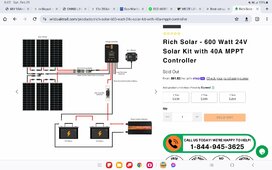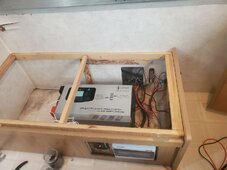hazed
New Member
New to the forum but have used it to help answer questions and get ideas in the past. However, I wanted to try to get some specifics from knowledgeable people in this forum. I have wired my own new construction house from the service to every outlet, so I have some decent experience, however, sometimes it is good to run questions by folks that know solar, as it is new to me.
Anyhow, I have a Thor motorhome and it has a 12v 100 watt panel on the roof. I ordered 6 more 12v 100 watt panels to add to that. After reading my overall goal, I will need to know if the original panel has slightly different specs, if it will truncate the panels it is hooked to, power-wise. I am looking to hook 4 panels together and 3 panels together at 12 volts each to bring 24v into the solar controller as lithium likes 14+ volts for better charging.
I am looking to purchase 3 Lifepo4 12v batteries that are 280-300ah each to have 840-900ah total.
I have a 3000w pure sine invereter with 6000w surge.
I will have to change my factory charger controller to a lithium compatible one.
Since I have yet to buy any other items or wires, can some of you help me with the specs on wire size or any equipment.
What do you recommend for wiring the panels together besides 2-1 connectors for 3 sets of panels and another set for the other 4 panels?
Wire size to solar controller?
Wire size from solar controller on?
Wire sizes anywhere else?
60 amp MPPT solar controller? Or, is that overkill if my motorhome from the factory only came with 30 amp service?
Any other thoughts or suggestions or quick sketch???
I am planning on being able to charge from the onboard generator or shore power, if necessary, so the new charger controller should have a built in transfer switch or I can use the factory standalone Southwire 30 amp transfer switch. With that said, I don't believe any wiring from the generator or otherwise will need replaced??? I do plan on running everything off of the inverter, as most things in the RV are 12v to include the refrigerator. There will be 110v for the microwave, water heater and mini split, but most of those will not ever run at the same time. The mini split is an inverter style, 9k btu's and runs about 716w on high at 110v.
I would like to find the best options to charge the batteries the fastest with solar and hopefully be able to run the mini split, likely not on high but auto at less watts, and find a happy medium to have the batteries maintain a charge while supporting the climate control.
I do not have a factory inverter, so I am not sure if my pure sine inverter will suufice, or if I should go with an inverter charger, or if that matters with solar.
Guessing something like the attached photo is what I am looking for but want the proper size wire for the least resistance.
Thank you very much in advance and I am sure there will be some additional back and forth!!
Anyhow, I have a Thor motorhome and it has a 12v 100 watt panel on the roof. I ordered 6 more 12v 100 watt panels to add to that. After reading my overall goal, I will need to know if the original panel has slightly different specs, if it will truncate the panels it is hooked to, power-wise. I am looking to hook 4 panels together and 3 panels together at 12 volts each to bring 24v into the solar controller as lithium likes 14+ volts for better charging.
I am looking to purchase 3 Lifepo4 12v batteries that are 280-300ah each to have 840-900ah total.
I have a 3000w pure sine invereter with 6000w surge.
I will have to change my factory charger controller to a lithium compatible one.
Since I have yet to buy any other items or wires, can some of you help me with the specs on wire size or any equipment.
What do you recommend for wiring the panels together besides 2-1 connectors for 3 sets of panels and another set for the other 4 panels?
Wire size to solar controller?
Wire size from solar controller on?
Wire sizes anywhere else?
60 amp MPPT solar controller? Or, is that overkill if my motorhome from the factory only came with 30 amp service?
Any other thoughts or suggestions or quick sketch???
I am planning on being able to charge from the onboard generator or shore power, if necessary, so the new charger controller should have a built in transfer switch or I can use the factory standalone Southwire 30 amp transfer switch. With that said, I don't believe any wiring from the generator or otherwise will need replaced??? I do plan on running everything off of the inverter, as most things in the RV are 12v to include the refrigerator. There will be 110v for the microwave, water heater and mini split, but most of those will not ever run at the same time. The mini split is an inverter style, 9k btu's and runs about 716w on high at 110v.
I would like to find the best options to charge the batteries the fastest with solar and hopefully be able to run the mini split, likely not on high but auto at less watts, and find a happy medium to have the batteries maintain a charge while supporting the climate control.
I do not have a factory inverter, so I am not sure if my pure sine inverter will suufice, or if I should go with an inverter charger, or if that matters with solar.
Guessing something like the attached photo is what I am looking for but want the proper size wire for the least resistance.
Thank you very much in advance and I am sure there will be some additional back and forth!!
Attachments
Last edited:





